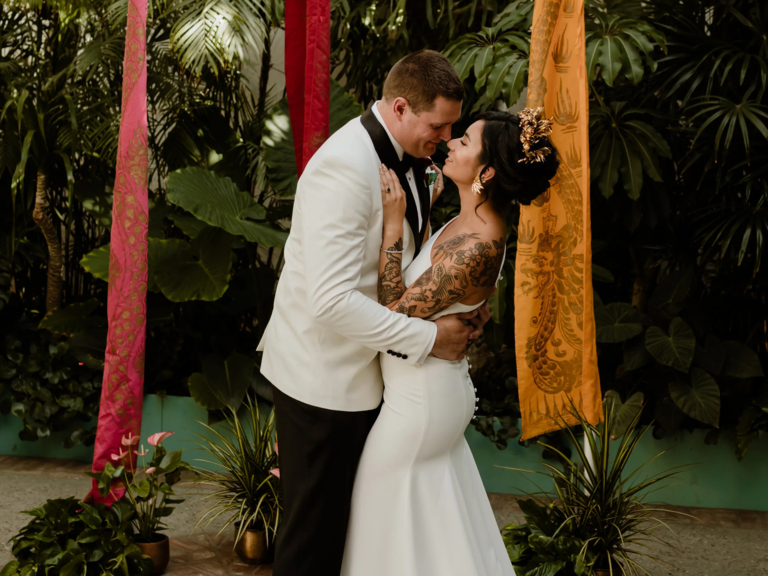Balinese Wedding Traditions and Customs to Know
Often referred to as the Island of the Gods, Bali is a destination that captures the hearts of travelers, especially honeymooners. It's full of breathtaking landscapes—terraced rice fields, serene beaches and majestic volcanoes. But the real magic of Bali lies in its deeply rooted culture and spirituality, which permeates daily life and celebrations, including Balinese weddings. It's a place where traditions aren't just practiced—they're lived and felt, making the Balinese experience one of the most memorable wedding traditions around the world.
If you've ever dreamed of tying the knot in Bali or incorporating a piece of its rich cultural heritage into your wedding day, you're in for something truly special. Balinese weddings are steeped in rituals that symbolize love, harmony and unity, creating not just a celebration but a deeply spiritual journey for the couple and their families.
What makes Balinese wedding traditions so unique is their emphasis on mindfulness and gratitude. From elaborate offerings to purification rituals, every detail is intentional and meaningful. Couples aren't just pledging their love to one another; they're seeking blessings from the gods, their ancestors and their community. It's a holistic approach to marriage that's as much about family and spirituality as it is about romance.
For couples planning a multicultural wedding, these traditions can make the experience feel even more immersive and authentic. For those not traveling to Bali for their nuptials, weaving elements of its traditions into their celebration can add a unique touch and a deeper sense of purpose to their big day. In this article, we'll explore some of the most cherished wedding traditions in Bali, from prewedding rituals to postceremony celebrations. To find vendors to make these traditions come to life, visit The Knot Vendor Marketplace.
Balinese Wedding Traditions: History | Prewedding | Attire | Ceremony | Reception | Food & Drink
A Brief History of Balinese Wedding Traditions
Bali wedding traditions are as rich and colorful as the island itself, rooted deeply in Hindu-Balinese culture and spirituality. For centuries, weddings in Bali have been seen as more than just a union between two people and more of a celebration of family and community. These traditions weave together love, respect and gratitude, making the ceremony not only a romantic milestone but also a meaningful spiritual event.
At the heart of Balinese weddings is the philosophy of "Tri Hita Karana," which translates to the "three causes of well-being." This belief emphasizes harmony between humans and the divine, harmony among people and harmony with nature. Every ritual and offering during the wedding reflects this philosophy, fostering balance and unity in the couple's new life together.
Back in the day, weddings in Bali were all about family connections, and arranged marriages were the norm. These unions weren't just about love—they carried a lot of social and spiritual responsibility. Fast forward to today, and while modern influences have shifted things toward love-based marriages, the heart of Balinese wedding traditions remains the same. It's still all about honoring the couple's bond and seeking blessings for a harmonious and balanced life together.
Rituals play a huge part in Balinese weddings, serving to purify, protect and bless the couple. Think vibrant offerings made of flowers, fruits and incense, paired with meaningful ceremonies led by a pemangku (priest). Every step is packed with symbolism, expressing gratitude to ancestors, nature and the gods. While some couples today opt for more contemporary ceremonies, many still incorporate these timeless Balinese rituals into their celebrations.
Prewedding Balinese Traditions
Before the wedding day and after any wedding proposal traditions, several meaningful traditions are observed to prepare the couple and their families for the sacred occasion. Here are a few of the most cherished prewedding Balinese wedding traditions.
Ngekeb: Preparing the Bride for Marriage
In this traditional ritual, the bride takes part in a purification ritual that helps her prepare for her new role as a wife. Held in the comfort of her family home, this ceremony often includes a fragrant flower bath and sacred offerings. These rituals symbolize her transition from her parents' care to her new life with her partner.
Mekalan-Kalan: Symbolizing Unity and Harmony
This prewedding tradition is all about celebrating the joining of two families. The couple makes offerings, such as canang sari (small handwoven baskets), fruits and cakes, sacred plants and leaves and traditional food, to honor their ancestors and the gods, asking for blessings as they start their life together. It's a meaningful practice that highlights the importance of unity—not just between the couple but also within their families and the wider community.
Honoring the Divine
Before the wedding day, families gather to craft beautiful and intricate offerings called banten. Made from flowers, rice, fruit and incense, these offerings are a cornerstone of Balinese traditional wedding rituals. They're carefully placed at family temples and sacred spaces as a way to show gratitude to the gods and ask for blessings on the couple's marriage.
Meeting with the Pemangku: Seeking Spiritual Guidance
A Balinese wedding wouldn't be complete without the wisdom of the pemangku (priest). Before the ceremony, the couple meets with the pemangku to receive blessings and guidance. This tradition ensures they're not just ready to say "I do" but also prepared to start a meaningful life together.
Traditional Balinese Wedding Attire
The Bali traditional wedding clothes worn by the bride, groom and their families play a big part in the wedding experience. Here's a closer look at some of the most iconic elements of Balinese wedding attire.
The Kebaya for the Bride
The kebaya is a traditional blouse-dress combination that is central to the bride's wedding attire. Made from luxurious fabrics like lace or silk, it hugs the bride's figure while showcasing intricate embroidery. It is often paired with a vibrant sarong (a long, wrapped skirt).
The Saput for the Groom
The groom's outfit typically features the saput, a decorative cloth wrapped around the waist and worn over a simpler base garment. The saput is often adorned with intricate patterns, such as gold-threaded designs that signify prosperity and strength, and paired with a tailored shirt or traditional jacket.
The Udeng Headpiece
The udeng is a traditional Balinese headpiece worn by the groom that's made from intricately folded fabric. In addition to its distinguished look, it also holds spiritual significance, as it serves to remind the groom of his responsibilities as a husband.



The Mahkota Crown
A Balinese bride often wears a striking gold crown called the mahkota. This ornate headpiece is often decorated with flowers and gold embellishments, symbolizing purity and divinity. In addition to the mahkota, brides often wear gold jewelry, including bangles, earrings and necklaces.
Vibrant Colors
Traditional Balinese wedding attire is known for its bold and vibrant colors, often featuring shades of red, gold and white. Each color carries its own meaning—red represents strength, gold symbolizes prosperity and white stands for purity.
Balinese Wedding Ceremony Traditions
Balinese ceremonies are rooted in tradition and designed to honor the couple, their families and the divine. Here are some Balinese wedding ceremony traditions worth noting.
The Melukat
The wedding day begins with melukat, a wedding blessing ritual that cleanses the couple spiritually and prepares them for their union. Using holy water, fragrant flowers and sacred offerings, the pemangku blesses the couple to clear away negative energy.
The Mewidhi Widana
During mewidhi widana, the couple seeks blessings from the gods to ensure their marriage is protected and prosperous. After their wedding ceremony entrances, the couple kneels before the family temple or altar, where they present offerings of fruit, flowers and incense. A pemangku leads the prayers, chanting mantras to call upon divine forces for guidance and harmony in the couple's journey ahead.
The Ngidih
During this part of the ceremony, the groom and his family formally request the bride's hand in marriage. This tradition involves presenting symbolic gifts to the bride's family, such as food, fabric and sacred offerings. Once the bride's family gives their blessing, the union is officially acknowledged.
Walking Around the Sacred Fire
In this ritual, the couple circles a sacred fire, representing the energy and passion of their union. As they walk together, the fire serves as a witness to their vows, purifying their intentions and binding them as one couple.
The Exchange of Betel Leaves
This is the heart of a traditional Bali wedding ceremony. The exchange of sirih pinang (betel leaves) symbolizes blessings for health, prosperity and happiness. The couple exchange the leaves with their families, signifying the merging of two households and the support of their loved ones.
Balinese Wedding Reception Traditions
From elaborate feasts to dances, here are some traditional Balinese wedding customs that make the reception unforgettable.
The Balinese Feast
No Bali traditional wedding reception is complete without a lavish feast featuring traditional dishes, including babi guling (suckling pig), lawar (a mix of vegetables, coconut and meat) and sate lilit (spiced minced meat skewers). These dishes are often served buffet-style, encouraging everyone to come together and share in the joy of the occasion.
Gamelan Music
Gamelan music is steeped in Balinese tradition and involves gongs, drums and xylophones. These sounds evoke a sense of community, spirituality and celebration, bringing positive energy and blessings to the couple.
Legong and Barong Dances
A traditional Balinese wedding will always incorporate the legong and barong, which feature intricate hand movements and gestures. Some couples may even participate in a dance themselves, symbolizing their unity and connection to their heritage.
The Giving of Banten
During the reception, the couple and their families often present banten, offerings made from flowers, fruit and incense, as a gesture of gratitude. This tradition reinforces the spiritual foundation of the wedding and expresses thanks to the gods and ancestors for their blessings.
Fireworks or Lantern Release
As the grand finale to any Balinese wedding is fireworks or the release of lanterns to symbolize hope and blessings for their future. Guests are often invited to participate, creating a magical moment of unity and shared wishes for the newlyweds.
Traditional Balinese Wedding Food, Drinks and Desserts
The culinary offerings at a traditional Balinese wedding are not to be forgotten. Not only are they delicious, but they also reflect the island's rich cultural heritage. Here's a taste of what you can expect when it comes to Balinese wedding food traditions.
Babi Guling
As we already mentioned, babi guling, or suckling pig, is a huge staple of any Balinese wedding feast. This iconic dish features a whole roasted pig seasoned with a blend of turmeric, garlic, lemongrass and other spices. The crispy skin and tender meat are served with rice, lawar (a mix of vegetables and coconut), and sambal (spicy chili paste).
Lawar
This dish of finely chopped vegetables, grated coconut and minced meat, seasoned with aromatic spices, comes in various versions, such as lawar babi (pork) or lawar ayam (chicken), and is often served with rice.
Es Daluman
Balinese weddings often serve es daluman, a refreshing jelly drink made from the leaves of the daluman plant (a type of grass jelly). Combined with coconut milk and palm sugar syrup, it's both sweet and soothing.
Dadar Gulung
Dadar gulung is a favorite dessert served at Balinese weddings. This green pancake, naturally colored with pandan leaf extract, is filled with grated coconut and palm sugar. Its green hue symbolizes new beginnings and growth.
Kopi Bali
To cap off the feast, guests are often served traditional Balinese coffee or kopi Bali. This rich and aromatic coffee is brewed with finely ground beans and sugar, resulting in a bold and flavorful drink.
Balinese Postwedding Traditions
Postwedding traditions are a major part of Balinese weddings, as they streamline the couple's transition into married life and celebrate the union of two families.
Ngaben Ceremony
After the wedding, many Balinese couples participate in a ngaben (cremation) ceremony to honor their ancestors. While this might sound unusual in the context of a wedding, it's a deeply spiritual act. The ritual pays respect to family members who have passed and seeks their blessings for the couple's future.
Mepandes Ceremony
In some cases, couples or family members may undergo the mepandes ceremony—also known as a tooth-filing ritual—after the wedding. This tradition, which symbolizes the transition from adolescence to adulthood, is a spiritual cleansing that signifies emotional and moral maturity.
Going Back to the Bride's Family Home
In traditional Balinese culture, the bride often moves into the groom's family home after the wedding. As part of the postwedding traditions, the couple returns to the bride's family home to express gratitude and build a bridge, so to speak, between the two families.
Blessing the New Home
If the couple has their own home, a blessing ceremony is conducted after the wedding to purify the space and invite positive energy. This involves offerings, prayers, and the burning of incense to ward off negative spirits.





















